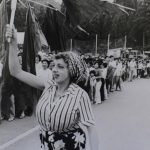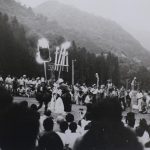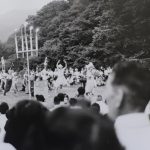Company: Welfare State International
Location: Togamura, Japan
Year: 1982
John Fox, Eyes on Stalks:
In 1982 Welfare State were invited to participate in the Togamura International Theatre Festival, supported by the diplomatic drive and funding from the British Council. The company spent three weeks in Japan preparing and presenting the event alongside 20 Japanese theatre students who helped the company prepare their open-air performances. The location of the festival was at Togamure, a mountain village 200 miles north of Tokyo. The exact location was on the mile long ski-slope on Mount Toka. There was a lot of publicity with live TV, with many famous actors, directors and fashion designers, including Issei Miyake, in attendance.
The three hour show was performed on three evenings in July. An audience of 300 gathered at a ski-lodge. Carry-On style usherettes with signs and Japanese torches lead the audience up the ski-slope. John and Sue’s ten year old daughter Hannah played a tin whistle, brining the audience to a circular plateau where Japanese tea was served. As darkness fell, mummering versions of the King Lear story in song and poetry were performed in English with simultaneous Japanese translation.
Out of the darkness a grotesque dinner party emerged, the banquet of decadent rulers feasted on noodles and fisticuffs accompanied by a string orchestra playing a distorted version of My Way. Following the feast a 30ft high King Lear type puppet came rumbling down the mountain, and an escaped gargoyle hurled blazing missiles towards the audience. The King blew up in a fireball of rage, his descent and fall was portrayed with startling effect with 15ft high blazing skleletons zooming down the resorts ski lift to the river below. A ‘mummers’ lament on solo violin was reprised while a recording of wailing man crying for his mother rose up.
A clown appeared, and dug through the wreckage to find the body of a burned child dressed as a Wagtail. The child came to life and lead the audience down the mountain to the next station. The King’s corpse was carried down the mountain on a stretcher, flamboyantly operated upon and resurrected into the Wagtail. Rather than have the sombre end of Shakespeare’s play, John and his colleagues worked in a theme of rebirth through the Japanese legend of the Wagtail, which according to folklore created the Northern Islands, and a procession of 40 lantern bearing children illustrated rebirth.
The company rounded off the evening with a riotous English style barn dance playing Waltzes, Polkas, Cumberland Square Eights alongside Ska and Reggae rhythms. Finally the coaches came to return the audience back to their hotels accompanied by bagpipes playing ‘Auld Lang Syne’.
The Wagtail and the Wasteland was voted the year’s best drama event by PIA magazine, rated as the Tokyo equivalent to Time Out.
The Wasteland and the Wagtail was the most product-based of all out international forays. Language, time, distance and cultural habits did not permit any extensive participation from the local community, although by journeying up a mountain to parallel the life of King Lear, perhaps we enabled our audience to become participants in a kind of pilgrimage. We certainly wished to break down the pattern you get at such international festivals where everyone is just passively consuming art products. By involving them in a processional ‘pilgrimage’ and social dancing, we gave them a tangible physical and mental experience, which maybe drew them together with some sense of belonging to a temporary community at least.’
Back to Welfare State International



